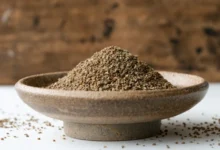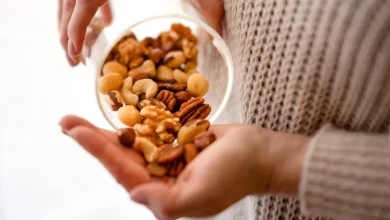Comprehensive Guide to Purine Levels in Foods
Purine Table

Understanding the purine content in foods is essential for managing conditions like gout and hyperuricemia. This guide provides a detailed purine table categorizing foods based on their purine levels, from highest to lowest.
Highest in Purines (400 mg uric acid/100 g and higher)
| Food | Total Purines (mg uric acid/100 g) | Min | Max | Nutrition Density (mg/MJ) |
|---|---|---|---|---|
| Fish, sardines in oil | 480 | 399 | 560 | 519.5 |
| Liver, Calf’s | 460 | 837.5 | ||
| Mushroom, flat, edible Boletus, dried | 488 | 932.8 | ||
| Neck sweet bread, Calf’s | 1260 | 3012.9 | ||
| Ox liver | 554 | 1013.3 | ||
| Ox spleen | 444 | 1052.6 | ||
| Pig’s heart | 530 | 1382 | ||
| Pig’s liver | 515 | 937.9 | ||
| Pig’s lungs (lights) | 434 | 911.2 | ||
| Pig’s spleen | 516 | 1208.2 | ||
| Sheep’s spleen | 773 | 1702.6 | ||
| Sprat, smoked | 804 | 795.6 | ||
| Theobromine | 2300 | 1611.3 | ||
| Yeast, Baker’s | 680 | 2071.3 | ||
| Yeast, Brewer’s | 1810 | 1866.6 |
Moderately High in Purines (100 to 400 mg uric acid/100 g)
| Food | Total Purines (mg uric acid/100 g) | Min | Max | Nutrition Density (mg/MJ) |
|---|---|---|---|---|
| Bean, seed, white, dry | 128 | 127.1 | ||
| Bean, Soya, seed, dry | 190 | 139.1 | ||
| Beef, chuck | 120 | 192 | ||
| Beef, fillet | 110 | 216.4 | ||
| Beef, fore rib, entrecote | 120 | 185.4 | ||
| Beef, muscles only | 133 | 292.1 | ||
| Beef, roast beef, sirloin | 110 | 110 | 120 | 201.4 |
| Beef, shoulder | 110 | 203.9 | ||
| Black gram (mungo bean), seed, dry | 222 | 194.3 | ||
| Caviar (real) | 144 | 141.6 | ||
| Chicken (breast with skin) | 175 | 288.4 | ||
| Chicken (chicken for roasting), average | 115 | 165.8 | ||
| Chicken, boiling fowl, average | 159 | 149.2 | ||
| Chicken, leg with skin, without bone | 110 | 152.2 | ||
| Duck, average | 138 | 146.2 | ||
| Fish, Anchovy | 239 | 560 | ||
| Fish, Carp | 160 | 330.9 | ||
| Fish, Cod | 109 | 335.9 | ||
| Fish, Haddock | 139 | 425.2 | ||
| Fish, Halibut | 178 | 439.9 | ||
| Fish, Herring roe | 190 | 342.4 | ||
| Fish, Herring, Atlantic | 210 | 216.9 | ||
| Fish, Herring, Matje cured | 219 | 197.6 | ||
| Fish, Mackerel | 145 | 95 | 194 | 191.2 |
| Fish, Pike-perch | 110 | 311.3 | ||
| Fish, Redfish (ocean perch) | 241 | 544.1 | ||
| Fish, Saithe (coalfish) | 163 | 473.4 | ||
| Fish, salmon | 170 | 110 | 250 | 202 |
| Fish, sardine, pilchard | 345 | 693.2 | ||
| Fish, Sole | 131 | 125 | 137 | 376.2 |
| Fish, trout | 297 | 686.7 | ||
| Fish, Tuna | 257 | 273.7 | ||
| Fish, Tuna in oil | 290 | 246.2 | ||
| Goose | 165 | 116.7 | ||
| Grape, dried, raisin, sultana | 107 | 86.4 | ||
| Ham, cooked | 131 | 248.1 | ||
| Heart, Sheep’s | 241 | 367.6 | ||
| Horse meat | 200 | 438.8 | ||
| Kidney, Calf’s | 218 | 419.6 | ||
| Lamb (muscles only) | 182 | 371 | ||
| Lentil, seed, dry | 127 | 114.45 | 164.65 | 93.8 |
| Linseed | 105 | 67.4 | ||
| Liver, chicken | 243 | 426.3 | ||
| Lobster | 118 | 60 | 175 | 346.4 |
| Lungs, Calf’s | 147 | 389.1 | ||
| Mussel | 112 | 391.5 | ||
| Ox heart | 256 | 504.3 | ||
| Ox kidney | 269 | 569.5 | ||
| Ox lungs (lights) | 399 | 961.4 | ||
| Ox tongue | 160 | 186 | ||
| Peas, chick (garbanzo), seed, dry | 109 | 84.2 | ||
| Pig’s kidney | 334 | 784.5 | ||
| Pig’s tongue | 136 | 208.2 | ||
| Pike | 140 | 406.7 | ||
| Poppy seed, seed, dry | 170 | 86 | ||
| Pork belly | 100 | 80 | 110 | 92.3 |
| Pork belly, raw, smoked dried | 127 | 82.6 | ||
| Pork chop with bone | 145 | 140 | 150 | 260 |
| Pork chuck | 140 | 135 | 145 | 170.4 |
| Pork fillet | 150 | 145 | 150 | 334.8 |
| Pork hip bone (hind leg) | 120 | 115 | 130 | 155 |
| Pork leg (hind leg) | 160 | 150 | 160 | 357.4 |
| Pork muscles only | 166 | 374.9 | ||
| Pork shoulder with skin (blade of shoulder) | 150 | 145 | 150 | 165.2 |
| Rabbit meat, average with bone | 132 | 95 | 150 | 207.7 |
| Rabbit/Hare (average) | 105 | 219.4 | ||
| Sausage “Jagdwurst” | 112 | 127.8 | ||
| Sausage salami, German | 104 | 65.9 | ||
| Sausage, liver (liverwurst) | 165 | 122.2 | ||
| Sausages, frying, from pork | 101 | 80.2 | ||
| Scallop | 136 | 505.8 | ||
| Shrimp, brown | 147 | 60 | 234 | 397.9 |
| Spleen, Calf’s | 343 | 815.9 | ||
| Sunflower seed, dry | 143 | 59.5 | ||
| Turkey, young animal, average, with skin | 150 | 237.3 | ||
| Veal chop, cutlet with bone | 140 | 309.6 | ||
| Veal fillet | 140 | 347.3 | ||
| Veal knuckle with bone | 150 | 140 | 160 | 353.2 |
| Veal, leg of veal with bone | 150 | 140 | 150 | 310.2 |
| Veal, muscles only | 172 | 438.7 | ||
| Veal, neck with bone | 150 | 326.9 | ||
| Veal, shoulder | 140 | 309.3 | ||
| Venison back | 105 | 205 | ||
| Venison haunch (leg) | 138 | 105 | 154 | 336.5 |
Lowest in Purines (100 mg uric acid/100 g and lower)
| Food | Total Purines (mg uric acid/100 g) | Min | Max | Nutrition Density (mg/MJ) |
|---|---|---|---|---|
| Almond, sweet | 37 | 15.7 | ||
| Apple | 14 | 60.1 | ||
| Apricot | 73 | 71.6 | ||
| Artichoke | 78 | 834.6 | ||
| Asparagus | 23 | 19.71 | 29.57 | 310.9 |
| Aubergine | 21 | 290 | ||
| Avocado | 19 | 20.9 | ||
| Bamboo Shoots | 29 | 402.1 | ||
| Banana | 57 | 152.4 | ||
| Barley without husk, whole grain | 96 | 71.1 | ||
| Bean sprouts, Soya | 80 | 378.3 | ||
| Beans, French (string beans, haricot) | 37 | 20 | 43 | 266.9 |
| Beans, French, dried | 45 | 40 | 50 | 39.4 |
| Beef, corned (German) | 57 | 96.5 | ||
| Beer, alcohol free | 8.1 | 75.4 | ||
| Beer, Pilsner lager beer, regular beer, German | 13 | 75.2 | ||
| Beer, real, light | 14 | 86 | ||
| Beet root | 19 | 15 | 21 | 108.5 |
| Bilberry, blueberry, huckleberry | 22 | 143.7 | ||
| Brain, Calf’s | 92 | 203.1 | ||
| Bread, wheat (flour) or (white bread) | 14 | 13.9 | ||
| Broccoli | 81 | 691.6 | ||
| Brussels sprouts | 69 | 456 | ||
| Cabbage, red | 32 | 19.79 | 36.62 | 350.2 |
| Cabbage, savoy | 37 | 19.87 | 42.71 | 342.6 |
| Cabbage, white | 22 | 210.3 | ||
| Carrot | 17 | 14 | 25 | 155.9 |
| Cauliflower | 51 | 537.9 | ||
| Caviar substitute | 18 | 37.8 | ||
| Celeriac | 30 | 390.6 | ||
| Cheese, Brie | 7.1 | 5 | ||
| Cheese, Cheddar/Cheshire cheese, 50% fat content | 6 | 4.3 | ||
| Cheese, cottage | 9.4 | 22 | ||
| Cheese, edam, 30% fat content in dry matter | 7.1 | 6.8 | ||
| Cheese, edam, 40% fat content in dry matter | 7.1 | 5.4 | ||
| Cheese, edam, 45% fat content in dry matter | 7.1 | 4.8 | ||
| Cheese, Limburger, 20% fat content in dry matter | 32 | 41.7 | ||
| Cherry, Morello | 17 | 75.5 | ||
| Cherry, sweet | 7.1 | 64.2 | ||
| Chicory | 12 | 171.8 | ||
| Chinese leaves | 21 | 412.4 | ||
| Chives | 67 | 581.2 | ||
| Cocoa powder, oil partially removed | 71 | 49.7 | ||
| Corn, sweet | 52 | 140.9 | ||
| Fish, Crayfish | 60 | 220.3 | ||
| Cress | 28 | 200.8 | ||
| Crispbread | 60 | 44.9 | ||
| Cucumber | 7.3 | 141.7 | ||
| Currant, red | 17 | 122.6 | ||
| Date, dried | 35 | 29.9 | ||
| Elderberry, black | 33 | 144.4 | ||
| Endive | 17 | 297.7 | ||
| Fennel leaves | 14 | 10 | 16 | 139 |
| Fig (dried) | 64 | 60.4 | ||
| Fish, eel (smoked) | 78 | 45 | 110 | 57.2 |
| Frankfurter sausages | 89 | 68.74 | 129.52 | 80.2 |
| Gooseberry | 16 | 101.3 | ||
| Grape | 27 | 94.6 | ||
| Grass, Viper’s (black salsify) | 71 | 939.4 | ||
| Kale | 48 | 309.1 | ||
| Kiwi fruit (Chinese gooseberry, strawberry peach | 19 | 88.5 | ||
| Kohlrabi | 25 | 10.86 | 29.61 | 243.9 |
| Leek | 74 | 714.1 | ||
| Lettuce | 13 | 9.75 | 29.25 | 274.4 |
| Lettuce, Lamb’s | 38 | 645.3 | ||
| Meat, luncheon | 70 | 58.8 | ||
| Melon, Cantelope | 33 | 143 | ||
| Millet, shucked corn | 62 | 41.9 | ||
| Morel | 30 | 748.9 | ||
| Mushroom | 58 | 55.48 | 60.52 | 858.2 |
| Mushroom, flat, edible Boletus | 92 | 1011.6 | ||
| Mushrooms, canned, solid and liquid | 29 | 488.5 | ||
| Mushrooms, Chanterelle | 17 | 356.2 | ||
| Mushrooms, Chanterelles, canned, solids & liquids | 17 | 114.2 | ||
| Nuts, Brazil | 23 | 8.3 | ||
| Nuts, hazelnut (cobnut) | 37 | 27 | 42 | 13.9 |
| Nuts, peanut | 79 | 33.8 | ||
| Oats, without husk, whole grain | 94 | 63.6 | ||
| Olive, green, marinated | 29 | 51.1 | ||
| Onion | 13 | 112.4 | ||
| Orange | 19 | 105.9 | ||
| Ox brain | 75 | 140.7 | ||
| Oyster | 90 | 322.6 | ||
| Oyster, mushroom | 50 | 1054.6 | ||
| Parsley, leaf | 57 | 266.2 | ||
| Pasta made with egg (noodles, macaroni, spaghetti) | 40 | 26.6 | ||
| Pea, pod and seed, green | 84 | 245.7 | ||
| Pea, seed, dry | 95 | 84.78 | 166.56 | 82.7 |
| Peach | 21 | 119.6 | ||
| Pear | 12 | 2 | 17 | 51.5 |
| Peppers, green | 55 | 681 | ||
| Pig’s brain | 83 | 161.71 | ||
| Pineapple | 19 | 81.4 | ||
| Plaice | 93 | 257.6 | ||
| Plum | 24 | 116.8 | ||
| Plum, dried | 64 | 67.9 | ||
| Potato | 16 | 53.6 | ||
| Potato, cooked with skin | 18 | 60.3 | ||
| Pudding, black | 55 | 37.23 | 90.55 | 42.8 |
| Pumpkin | 44 | 422 | ||
| Quince | 30 | 185 | ||
| Radish | 15 | 234.3 | ||
| Radishes | 13 | 210.6 | ||
| Raspberry | 18 | 126.3 | ||
| Rhubarb | 12 | 212.6 | ||
| Rolls, bread | 21 | 18.2 | ||
| Rye, whole grain | 51 | 47 | 63 | 41 |
| Sauerkraut, dripped off | 16 | 12 | 20 | 224.7 |
| Sausage “Bierschincken” | 85 | 117.3 | ||
| Sausage “Fleischwurst” | 78 | 66.8 | ||
| Sausage “Mortadella” | 96 | 79 | 130 | 67.4 |
| Sausage “Munich Weisswurst” | 73 | 65.7 | ||
| Sausage, Vienna | 78 | 65.7 | ||
| Sausages, frying, from veal | 91 | 81.5 | ||
| Sausages, German (Mettwurst) | 74 | 45.9 | ||
| Sesame (gingelly) seed, Oriental, dry | 62 | 26.5 | ||
| Spinach | 57 | 844.7 | ||
| Squash, summer | 24 | 296.2 | ||
| Strawberry | 21 | 11.81 | 25.59 | 156.8 |
| Tench | 80 | 243.8 | ||
| Tofu | 68 | 196.4 | ||
| Tomato | 11 | 145.7 | ||
| Nuts, Walnut | 25 | 9.1 | ||
| Wheat, whole grain | 51 | 40.2 | 83.41 | 39.4 |
| Yogurt, min. 3.5% fat content | 8.1 | 27.7 |
It is essential to note that food typically accounts for only about 30% of the uric acid content in the blood serum. While diet is crucial for those wishing to lower their uric acid levels, other factors such as physical exertion and traumatic injuries can also contribute to the occurrence of gout. Additionally, foods that elevate blood acidity may aggravate gout, even if they have low purine content. These include spicy and greasy foods, coffee, alcohol, excess tea, and deeply fried foods.
Low Purine, Whole Foods Vegetarian Diet Plan for Hyperuricemia
Breakfast
- Smoothie Bowl
- Ingredients: Bananas, blueberries, almond milk, chia seeds, and a handful of almonds.
- Preparation: Blend the bananas, blueberries, and almond milk. Pour into a bowl and top with chia seeds and almonds.
- Avocado and Tomato Slices
- Ingredients: Avocado, cherry tomatoes, salt, and pepper.
- Preparation: Slice the avocado and cherry tomatoes. Sprinkle with salt and pepper.
- Skimmed Cow Milk
- Ingredients: Skimmed cow milk.
- Preparation: Drink a glass of chilled skimmed cow milk alongside your breakfast.
Snack
- Apple Slices with Almond Butter
- Ingredients: Apple, almond butter.
- Preparation: Slice the apple and dip it in almond butter.
Lunch
- Quinoa Salad
- Ingredients: Quinoa, cucumber, cherry tomatoes, bell peppers, red onion, olive oil, lemon juice, and fresh herbs (like parsley or cilantro).
- Preparation: Cook the quinoa and let it cool. Mix with chopped vegetables, olive oil, lemon juice, and herbs.
- Vegetable Soup
- Ingredients: Carrots, celery, tomatoes, garlic, vegetable broth, and your choice of spices.
- Preparation: Sauté garlic and vegetables in a pot. Add vegetable broth and spices. Simmer until vegetables are tender.
- Curd (Yogurt)
- Ingredients: Plain curd (yogurt).
- Preparation: Enjoy a bowl of plain curd as a side with your lunch.
Snack
- Mixed Berries
- Ingredients: Strawberries, blueberries, raspberries.
- Preparation: Mix and enjoy.
Dinner
- Stuffed Bell Peppers
- Ingredients: Bell peppers, cooked quinoa, black beans, corn, diced tomatoes, onion, garlic, and spices (such as cumin and paprika).
- Preparation: Sauté onion and garlic, add black beans, corn, diced tomatoes, and spices. Mix with cooked quinoa. Stuff the mixture into bell peppers and bake until peppers are tender.
- Stir-Fried Vegetables with Brown Rice
- Ingredients: Broccoli, cauliflower, carrots, bell peppers, snap peas, garlic, soy sauce, and brown rice.
- Preparation: Stir-fry the vegetables and garlic in a bit of olive oil. Add soy sauce to taste. Serve over cooked brown rice.
- Curd (Yogurt)
- Ingredients: Plain curd (yogurt).
- Preparation: Enjoy a bowl of plain curd as a side with your dinner.
Dessert
- Fresh Fruit Salad
- Ingredients: Mixed fruits like watermelon, cantaloupe, kiwi, and berries.
- Preparation: Chop and mix the fruits.
Additional Tips
- Hydrate: Drink plenty of water throughout the day.
- Limit Alcohol and Sugary Beverages: Stick to water, herbal teas, and diluted fruit juices.
- Maintain a Balanced Diet: Include a variety of fruits, vegetables, whole grains, and nuts.
- Regular Physical Activity: Engage in moderate exercise regularly to help maintain a healthy weight and overall well-being.
By following this diet plan and making healthy lifestyle choices, you can help manage hyperuricemia and reduce the risk of gout flare-ups.
References:
- Elevate Health AZ. (n.d.). Purine Table. PDF.
- National Center for Biotechnology Information. (2017). Clinical Methods: The History, Physical, and Laboratory Examinations. Book.








